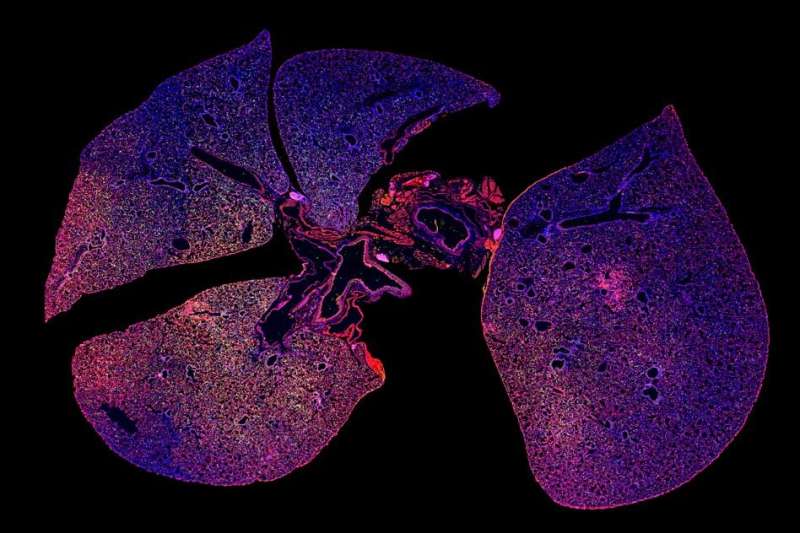With these nanoparticles, a simple urine test could diagnose bacterial pneumonia

Pneumonia, a respiratory disease that kills about 50,000 people in the United States every year, can be caused by many different microbes, including bacteria and viruses. Rapid detection of pneumonia is critical for effective treatment, especially in hospital-acquired cases which are often more severe. However, current diagnostic approaches often take several days to return definitive results, making it harder for doctors to prescribe the right treatment.
MIT researchers have now developed a nanoparticle-based technology that could be used to improve the speed of diagnosis. This type of sensor could also be used to monitor whether antibiotic therapy has successfully treated the infection, says Sangeeta Bhatia, the John and Dorothy Wilson Professor of Health Sciences and Technology and Electrical Engineering and Computer Science and the senior author of the study.
"If the patient's symptoms go away, then you assume the drug is working. But if the patient's symptoms don't go away, then you would want to see if the bacteria is still growing. We were trying to address that issue," says Bhatia, who is also a member of MIT's Koch Institute for Integrative Cancer Research and Institute for Medical Engineering and Science.
Graduate student Colin Buss and recent Ph.D. recipient Jaideep Dudani are the lead authors of the paper, which appears online Nov. 29 in the journal EBioMedicine. Reid Akana, an MIT senior, and Heather Fleming, director of research for Bhatia's lab, are also authors of the paper.
Sensors in the body
Several years ago, Bhatia and her colleagues developed a diagnostic approach that amplifies a signal from biomarkers already present in the body—specifically, enzymes called proteases, which chop up other proteins. The human genome encodes more than 500 different proteases, each of which targets different proteins.
The team developed nanoparticles coated with peptides (short proteins) that can be chopped up by certain proteases, such as those expressed by cancer cells. When these particles are injected into the body, they accumulate in tumors, if any are present, and proteases there chop the peptides from the nanoparticles. These peptides are eliminated as waste and can be detected by a simple urine test.
"We've been working on this idea that measuring enzyme activity could be a new way to peer inside the body," Bhatia says.
In recent studies, she has shown that this approach can be used to detect different types of cancers, including very small ovarian tumors, which could enable earlier diagnosis of ovarian cancer.
For their new study, the researchers wanted to explore the possibility of diagnosing infection by detecting proteases that are produced by microbes. They began with a species of bacteria called Pseudomonas aeruginosa, which can cause pneumonia and is a particularly common cause of hospital-acquired cases. Pseudomonas expresses a protease called LasA, so the researchers designed nanoparticles with peptides that can be cleaved by LasA.
The researchers also developed a second nanoparticle-based sensor that can monitor the host's immune response to infection. These nanoparticles are covered in peptides that are cleaved by a type of protease called elastase, which is produced by immune cells called neutrophils.
In some patients with pneumonia, even if an antibiotic clears out the bacteria causing the infection, a chest X-ray may still show inflammation because neutrophils are still active. Using these two sensors together could reveal whether an antibiotic has cleared the infection, in cases where a chest X-ray still shows inflammation after treatment.
"The sensors can help you distinguish between whether there's an infection and inflammation, versus inflammation and no infection," Bhatia says. "What we showed in the paper is that when you treat with the right antibiotic, the infection goes down but the inflammation persists."
The researchers also showed that if they treated mice with an ineffective antibiotic, both bacteria levels and inflammation levels stayed high. This kind of test could help to reveal whether an antibiotic is working, in cases where a patient's symptoms haven't improved within a few days.
Diagnosing many infections
For this study, the researchers delivered the nanoparticles intravenously, but they are now working on a powdered version that could be inhaled.
Bhatia envisions that this approach could be used to determine whether a patient has bacterial or viral pneumonia, which would help doctors to decide if the patient should be given antibiotics or not. The definitive test, growing a bacterial culture from coughed up mucus, takes several days, so doctors base their decisions on the patients' symptoms and X-ray imaging—a process that may not always be accurate.
To create a more comprehensive diagnostic, Bhatia's lab is now working on adding peptides that could interact with proteases from other types of bacteria that cause pneumonia, as well as proteases that the host immune system produces in response to either viral or bacterial infection. The researchers are also working on sensors that could easily distinguish between active and dormant forms of tuberculosis.
Bhatia and others have started a company called Glympse Bio that has licensed the protease sensing technology and is now working on developing protease sensors for possible use in humans. Next year, they plan to begin a phase I clinical trial of a sensor that can detect liver fibrosis, an accumulation of scar tissue that can lead to cirrhosis.
Journal information: EBioMedicine
Provided by Massachusetts Institute of Technology




















